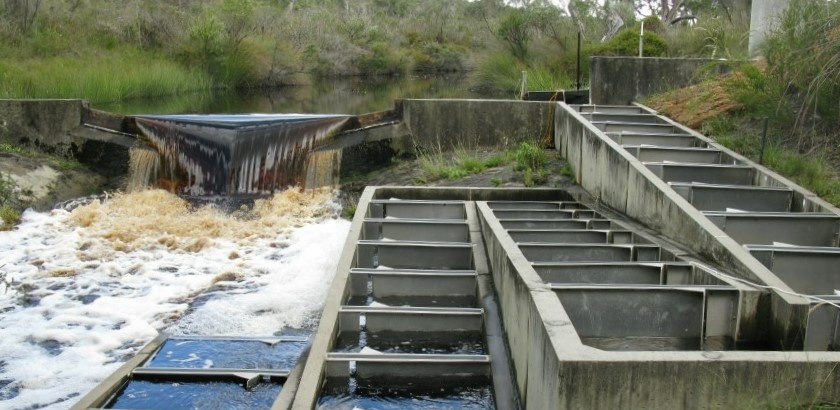Connectivity of waterways
A section of waterway is connected to its floodplain (lateral connectivity) and to the waterway upstream and downstream (longitudinal connectivity). These connections influence the movement of sediment, nutrients, carbon and animals through a river system and so they are important for the health of a waterway.
Seasonal inundation of the floodplain (the area next to a waterway) is an important process for the exchange of sediment, nutrients and carbon between the waterway and floodplain. For example, as water spills out of the waterway channel and onto its floodplain, the flow slows down considerably and sediment being carried in the water is deposited. This reduces the amount of sediment carried further downstream in the waterway and enriches the floodplain sediments, making these fertile habitats.
Floodplains provide important habitats for fish and crayfish, frogs and wading birds. For some species seasonal flooding of these areas is crucial for a stage of their life cycle. Many native fish species move into the floodplain and seasonal creeks during winter to reproduce in the flooded vegetation (Morgan et al 1998). The juvenile fish develop in these nursery areas before moving back into more permanent waterways. For information about the importance of floodplains, go to River Restoration Manual - Waterway ecology and Habitat of rivers and creeks (Water note 8).
The connection between a section of a waterway and the waterway upstream and downstream (longitudinal connectivity) is also important for many aquatic animals. Fish move through river systems for many reasons including for feeding, avoiding predators or poor water quality, migrating to breeding/spawning/nursery areas, seasonal habitats and to colonise new territory.
Barriers to connectivity
Natural and man-made barriers can restrict the movement of aquatic fauna (referred to as fish passage) leading to increased competition for food and habitat, increased predation and the interruption of natural breeding/spawning cycles (Fairfull & Witheridge 2003). In addition, when barriers separate a population of a fish species into localised groups, it can affect the genetic diversity of a group and reduce their resilience to predation and environmental changes.
Man-made barriers that have the potential to prevent movement of fish include dams, weirs, flow gauging stations, fords and culverts. The extent to which a structure forms a barrier to fish passage depends on a combination of factors including the structure's size and the flow regime of the waterway (which together determine how frequently water flows over the structure), the fish species present, their migration patterns and the location of the structures in relation to those patterns.
The following publications provide information and guidance about barriers and the movement of aquatic animals:
- Simple fishways (Water note 26)
- Stormwater management manual Chapter 9 - Best Management Practice 4.3 - Living streams
- Reconnecting off-channel habitats to waterways – using engineering techniques to restore fish passage)
Barriers that prevent the movement of fish can also have a negative effect on other aspects of waterway condition. Barriers can:
- prevent the movement of organic material along waterways. It builds up in pools upstream from the barrier and can lead to poor water quality (e.g. increased nutrients and contaminants, reduced dissolved oxygen, shallower warmer water).
- reduce the flow of water along a waterway leading to stagnant areas upstream from barriers. These areas tend to have poor water quality and provide an ideal habitat for the growth of nuisance species such as aquatic weeds, mosquitos, midges and introduced fish species.
- reduce the depth of water downstream of barriers. This can lead to increased water temperatures and lower dissolved oxygen. Fish and aquatic macroinvertebrate species have different water quality requirements and some may be unable to tolerate the conditions in these shallow areas.
- increase the flooding of riparian vegetation upstream of barriers and decrease the water available to vegetation downstream from the barrier. This can change the species able to live in these areas and in some cases can lead to reduced vegetation cover which impacts waterway health (see aquatic and riparian vegetation for details).
What we do
Show moreOur Healthy Rivers program assesses waterway condition at a range of sites across the south west. The connectivity of a waterway is an important indicator of its health and forms one component in the South West Index of River Condition.
The Department of Water and Environmental Regulation determines and manages the flow regimes necessary to maintain or enhance the ecological values of selected rivers through the water allocation planning process.
We assess and grant licences to take water and to interfere with the bed and banks of certain watercourses. For activities such as dams, weirs, river crossings and culverts, which may form barriers to waterway connectivity, we may apply conditions to maintain fish passage.
We also support the Environmental Protection Authority when they conduct environmental impact assessments of significant proposals, including developments with the potential to affect the connectivity of surface water systems or create barriers to fauna movement (such as major dams or bridges). Refer to the Environmental Factor Guidelines – Inland Waters for more information.
References
Show moreMorgan DL, Gill HS & Potter IC 1998, Distribution, identification and biology of freshwater fishes in south-western Australia: records of the Western Australian Museum, Supplement no. 56, Western Australian Museum, Perth.
Fairfull, S & Witheridge, G 2003, Why do fish need to cross the road? Fish passage requirements for waterway crossings, NSW Fisheries, Cronulla.



